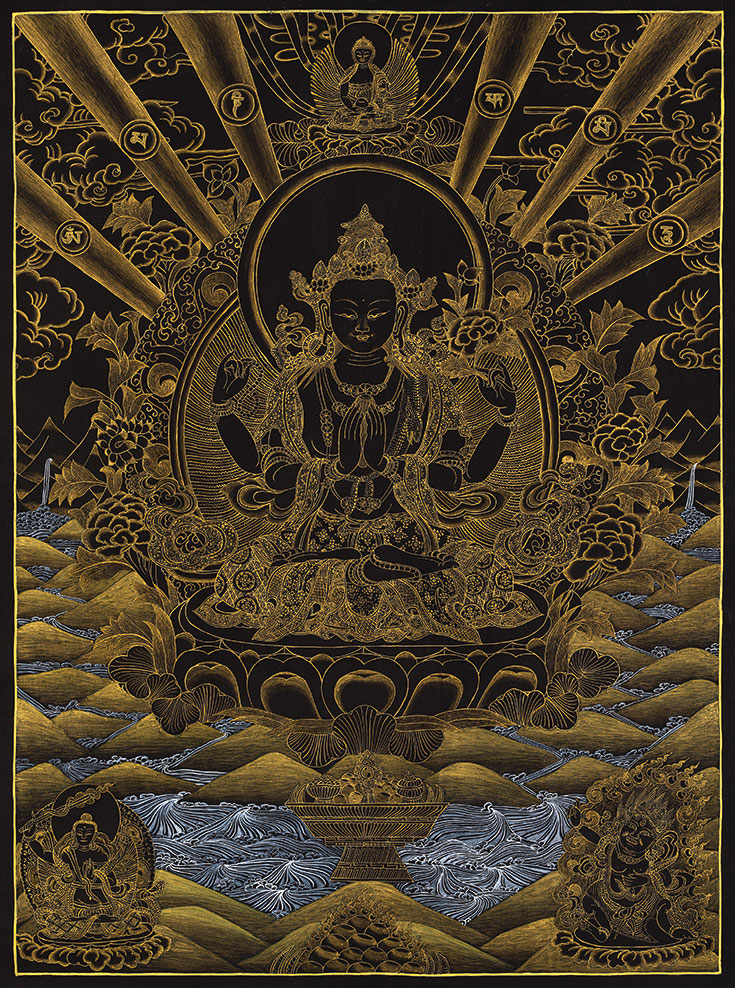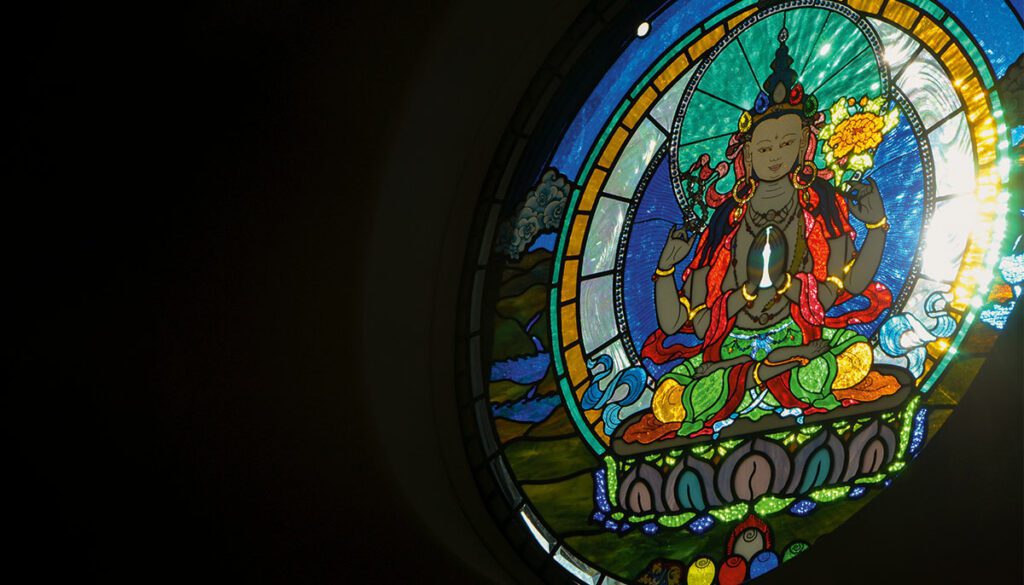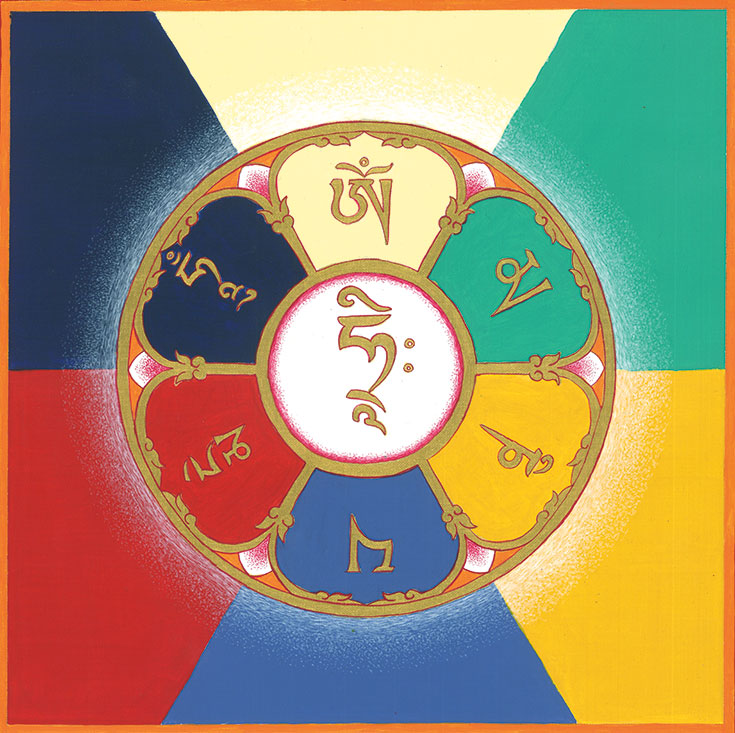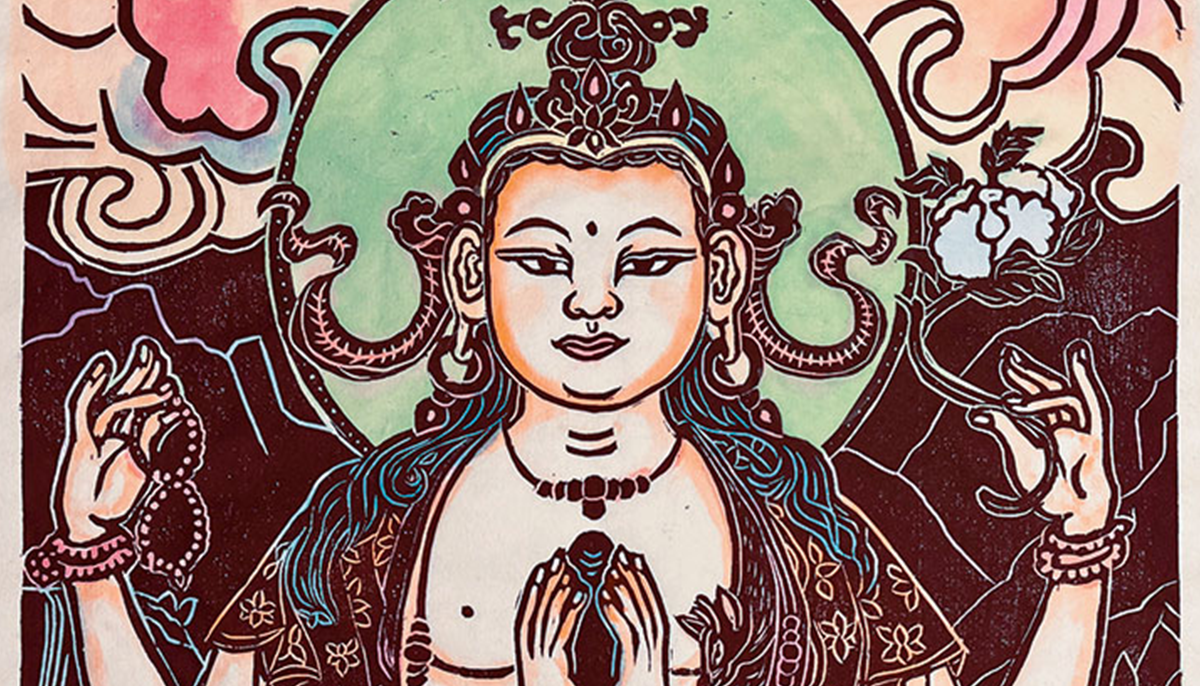The bodhisattva Chenrezig is the embodiment of primordial compassion that unceasingly manifests to hold and alleviate suffering. This boundless compassion and altruistic intention are innate to each of us, but are veiled to us by our habitual ways of perceiving. Chenrezig shows us our true nature—our unveiled, genuine heart.
In India, Chenrezig is known as Avalokitesvara. Ava means “down,” lokita means “see” or “gaze,” and ishvara means “powerful being.” So, Avalokitesvara is the powerful one who gazes upon all beings with compassion.
An early Mahayana text, the Lotus Sutra, contains one of the first known references to Avalokitesvara. As Buddhism spread throughout Asia, he was embraced by different cultures, inspiring diverse names and forms. In Japan, China, and Vietnam, he appears as female, going by the names Kannon, Guanyin, and Quan Am respectively. His Tibetan name, Chenrezig, literally means “all-seeing eye.”

Chenrezig plays a central role Vajrayana Buddhism, and in Tibet his mantra, Om Mani Padme Hung, is a continuous refrain. In various iterations, Chenrezig appears with distinct forms, colors, demeanors, ornaments, implements, postures, and mudras. Some of the most well-known forms include four-armed Chenrezig and thousand-armed Chenrezig. The iconography and attributes of his different forms illuminate various aspects of his compassion and the variety of his skillful means. Regardless of the form he assumes, he’s in essence the union of wisdom and compassion, and he perfectly embodies the bodhisattva commitment.
Chenrezig embodies the divine masculine. Manifestations of awakened qualities (yidams) arise in male, female, and nonbinary bodies, but not in the sense of the conventional understanding of gender. From a Vajrayana Buddhist perspective, we all encompass both masculine and feminine qualities. The masculine qualities include coolness, clarity, compassion, and skillful means, while the feminine qualities encapsulate warmth, wisdom, emptiness, and receptivity. Yidams, such as Chenrezig, arise in bodies of light rather than bodies of flesh and blood. They embody a balance and union of the essential, energetic masculine and feminine aspects, and they arise in masculine, feminine, or nonbinary forms as skillful means to guide our personal journey of cultivating this balance and union within ourselves and ultimately recognizing our buddhanature. In developing our connection with Chenrezig, we foster the masculine aspect of our being—the qualities of clarity, compassion, and skillful means.
As we engage in Chenrezig practice, we come to better understand the essential nature of form and embodiment. We do this by letting go of our habitual ways of experiencing ourselves and others and assuming the awakened nature of Chenrezig. We view ourselves and all beings as Chenrezig and our environment to be an exquisite pure land where all that we encounter brings joy and bliss. We come to learn that all form, including ourselves, is the radiance of awakened awareness. Being awakened awareness, all form is sacred, imbued with meaning, and it’s not defined or limited by the quagmire of conditioned existence with its manufactured divisions and hierarchies. Form manifests in countless unique variations, much like radiant light refracted through the multifaceted surfaces of a crystal unveils different hues of the same luminous truth. Chenrezig’s embodiment, the very essence of benevolent intent and action, mirrors our own and all beings’ potential.
The most prevalent form of Chenrezig arises in a white body with four arms. As a yidam, his white color transcends the social construct of race, as melanin levels hold no relevance in this context. Yidams emerge as blue, white, yellow, red, or green. These colors, which represent specific facets of wisdom, correspond to the five buddha families. In the Buddhist tantra tradition, the buddha families represent five types of energy that comprise all of our experience, including our emotions. These can be experienced as either confusion or wisdom depending on the degree to which we’re caught up in conceptuality and a sense of self. The families are embodied by five primordial buddhas who are arranged in a mandala. Chenrezig’s radiant white form signifies the embodiment of spacious, all-encompassing awareness dispelling the veils of ignorance.
Being an embodiment of wisdom and compassion, every aspect of Chenrezig’s appearance is meaningful. The arms of the four-armed Chenrezig are manifestations of the four divine abodes: loving-kindness, compassion, empathetic joy, and equanimity. His first hands rest in prayer mudra at his heart, cradling a wish-fulfilling jewel as he implores the buddhas to fulfill all beings’ needs and aspirations. The tenderness with which he holds this jewel reflects his care for each of us. His second right hand holds a crystal mala, and with each bead that he draws, he liberates a being from the cyclic dance of birth, death, and rebirth. In his second left hand he gracefully holds a lotus because, just as a lotus blossoms unstained by the mud from which it arises, he manifests within our imperfect world of form without being marred by it.
Seated upon a lotus and moon with his legs folded in lotus posture, Chenrezig exemplifies the realization of the inseparability of emptiness and compassion. His mastery of the five wisdoms finds expression in his five white and red silk scarves. The six paramitas—generosity, joyful diligence, patience, ethical conduct, concentration, and wisdom—shine forth as his gold and jeweled earrings, trio of necklaces, belt, and bangles at his wrists, elbows, and ankles. A deerskin is draped over his left shoulder, reflecting his gentle selflessness.
Chenrezig’s one face symbolizes that all phenomena are of the same essence. His black hair is partially drawn into a topknot, symbolizing his complete realization, while the rest of his hair cascades down his back, symbolizing his bodhisattva commitment to benefit all beings ensnared in suffering. His five-jeweled crown indicates that he has realized the essence of the five disturbing emotions to be the five wisdoms. A full moon supports his back as his cool radiance relieves the heat of our distress and suffering.

Sitting atop Chenrezig’s topknot is his guru Amitabha, the red buddha of the Padma buddha family, embodying the wisdom of discernment. In English, Amitabha’s name is Buddha of Limitless Light, and he resides in the pure land of Dewachen, Land of Bliss. Amitabha created this pure land to be a place where ordinary beings like us can be reborn and attain enlightenment. This makes Dewachen unique, and it reflects Amitabha’s great compassion for all who wander in cyclic existence.
Legend recounts that Amitabha, upon contemplating the suffering of sentient beings, was inspired to emanate bodhisattvas who could manifest in cyclic existence to relieve the suffering of beings and guide them to awakening. He radiated white light from his right eye and green light from his left. The green light transformed into Tara, and the white light gave birth to Chenrezig.
Chenrezig was discovered floating on a lotus in a lake by a king’s attendant. The king, who had fervently prayed for a son to be his heir, thought this being who emanated a boundless field of compassion was a response to his prayers. He invited this boy, adorned with silks and jewels, to live with him at the palace. Meanwhile, the king went to Amitabha to inquire about this enigmatic being. Amitabha revealed the boy to be Chenrezig, an emanation of all buddhas’ collective activity, who would benefit innumerable beings.
From the palace, Chenrezig gazed upon all beings, deeply attuning to the ache of their suffering. Overwhelmed, he wept. From his tears two forms of Tara emerged. They consoled Chenrezig, told him that they would collaborate with him to liberate beings, and dissolved into him. Strengthened by their compassion and shared mission, Chenrezig vowed in Amitabha’s presence to persist unwaveringly in his activity until every last being was liberated from suffering.
Knowing well the depths of suffering, Chenrezig is immutably committed to serve as a stabilizing, soothing, and compassionate presence that aids in our healing from trauma, holds with us our fear and anxiety, and shows us our boundless compassionate heart as we hold our pain and that of all beings, the planet, and beyond. Ultimately, Chenrezig leads us to enlightenment. He’s like a refreshing, cool breeze on a scorching summer day. Like the reflection of a luminous full moon on water, his presence evokes ease and internal spaciousness no matter how difficult circumstances may be.
How to Do Chenrezig Practice

You can invoke Chenrezig’s presence at any moment by simply chanting his mantra, Om Mani Padme Hung. Reciting the Chenrezig mantra reinforces our indivisible bond with him while instantly connecting us to his continuous, compassionate support. For a more formal Chenrezig practice, follow the steps below.
1. Take Refuge
Find a quiet place to settle into a posture that allows you to be alert yet relaxed. Take several full breaths, breathing in loving-kindness and exhaling all thoughts and concerns, allowing your mind and body to relax into the present moment. When settled, take refuge in all awakened beings and your innate basic goodness by reciting: “Until awakening, I take refuge in the Buddha, dharma, and noble sangha. By the merit of my acts of generosity and other awakening qualities, may I attain full awakening for the benefit of all beings.”
2. Visualize Hri Above Your Head
With eyes open, gaze into the sky in front of you, taking in the vast openness of space with receptivity. Tune into the inherently compassionate nature of this vast openness. Visualize that, a forearm’s length above your head, this compassion unimpededly blossoms as a lotus and moon seat. Visualize that above the moon disc, the seed syllable Hri, the essence of Chenrezig’s awakened mind, instantly appears like a white flash of lightening. To familiarize yourself with what Hri looks like, see the symbol in the center of the lotus on the next page.
3. Visualize Hri Turning into Chenrezig
The Hri radiates brilliant light in all directions, purifying the environment and all beings’ obscuring emotions, and makes offerings to all awakened beings. The blessings of the awakened beings return as light that’s absorbed into the Hri. The Hri then instantly transmutes into Chenrezig. His body is translucent and made of white light, like a snowy mountain illuminated by the morning sun. His form is apparent yet insubstantial. He’s resplendent with silks and jewels.
4. Empower Your Visualization
Visualize that white, red, and blue light radiates from Chenrezig’s forehead, throat, and heart respectively, invoking the blessings of Chenrezig’s wisdom and compassionate presence. In response to your invocation, countless forms of Chenrezig rain down and dissolve into your visualization, like snowflakes merging with a snow-covered mountaintop. Have confidence that Chenrezig is truly appearing above your head. He looks upon you and all beings with love and care.
5. Bow and Make Offerings to Chenrezig
Take a moment to feel and be held by Chenrezig’s steady, soothing, and compassionate presence. Internally bow to Chenrezig with respect and gratitude. Visualize making abundant offerings of things that delight the senses, and pray for his blessing for yourself and all beings.
6. Know That You Are Chenrezig
In response to your respect and prayers, Chenrezig dissolves into light and enters the crown of your head. The light descends to your heart center and then radiates out in all directions. As it illuminates your body, your ordinary body is revealed to be a body of white light, apparent yet insubstantial. You are Chenrezig. Your body, speech, and mind are inseparable from his. Your innate, limitless loving-kindness, compassion, sympathetic joy, and equanimity arise as four arms. Your awakened qualities adorn you as silks and jewels.
7. Chant Chenrezig’s Mantra
Visualize that Chenrezig’s seed syllable and mantra are written on a six-petaled lotus that’s in your heart center. The seed syllable, Hri, is white and at the center of the lotus, while each syllable of the mantra is on a different petal. Om is white, Ma is green, Ni is yellow, Pad is light blue, Me is red, and Hung is dark blue. These syllables face in toward the Hri and are arranged clockwise. As you chant the mantra, feel yourself and all beings receiving Chenrezig’s blessing and compassion as the mantra radiates light from your heart. White light from Om purifies the body, green light from Ma purifies speech, yellow light from Ni purifies mind, light blue light from Pad purifies all disturbing emotions, red light from Me purifies all latent conditioning, and dark blue light from Hung purifies all obscurations to knowledge.
8. Dissolve the Visualization
When you’re done reciting the mantra, take a moment to feel its impact and your connection with Chenrezig. Then, gradually dissolve the visualization of the mantra until all that remains is the white Hri. It brilliantly radiates the essence of your mind inseparable from the mind of Chenrezig. Hri dissolves into a tiny drop of white light, which then dissolves into space, like a rainbow disappearing into the sky. Rest your mind naturally for a few minutes or longer.
9. Share the Benefit
End your session by sharing the benefit of the practice with all beings by reciting: “Through this goodness may awakening spontaneously arise in our streams of being. May all obscurations and distortions fall away. May all beings be liberated from suffering and the stormy waves of birth, sickness, old age, and death.”
This article is from the March 2024 issue of Lion’s Roar magazine.
